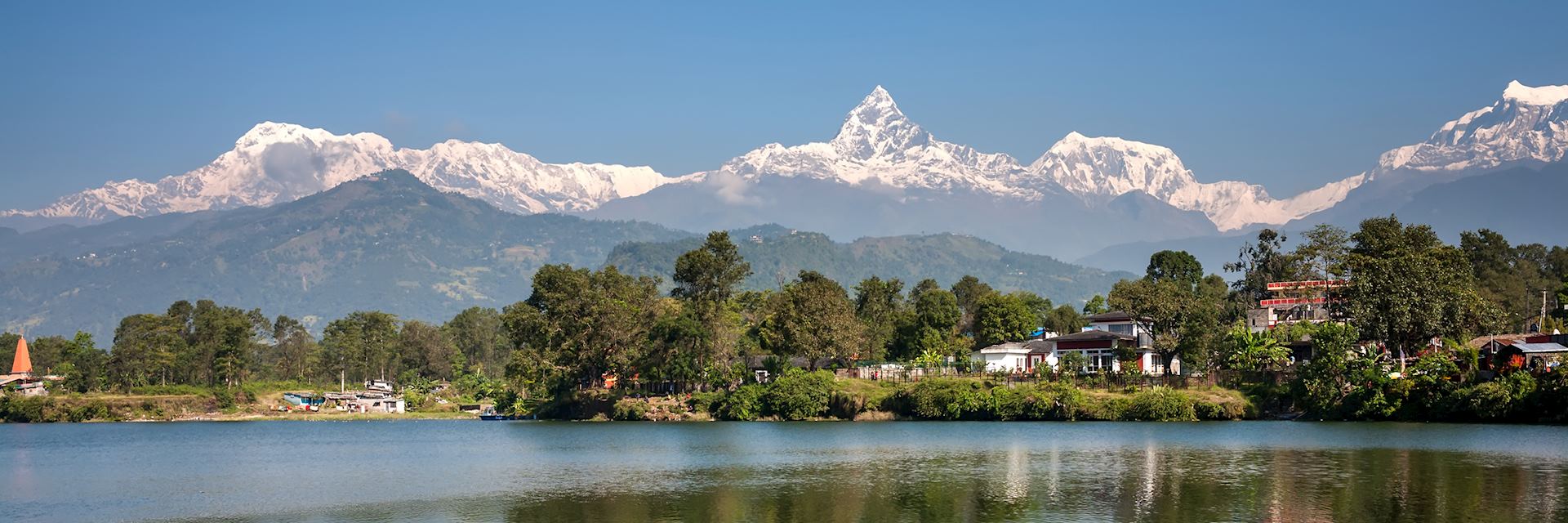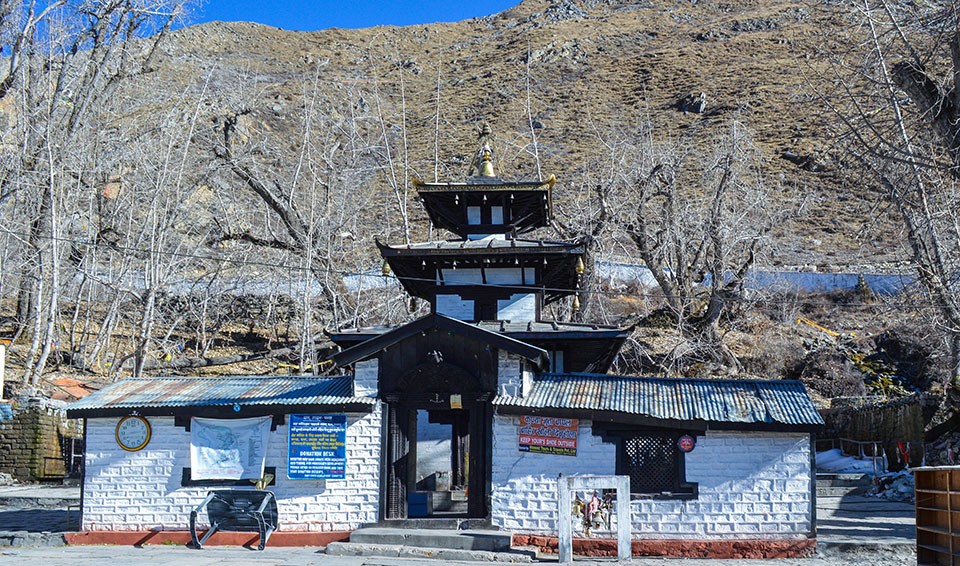The Annapurna Region in Nepal is a trekker's paradise, renowned for its stunning mountain scenery, diverse landscapes, and rich cultural heritage. Named after the majestic Annapurna mountain range, which includes several peaks over 7,000 meters tall, this region offers a variety of trekking routes catering to all levels of experience.
Trekking in the Annapurna Region allows travelers to immerse themselves in a kaleidoscope of natural wonders, from lush subtropical forests and terraced fields to high alpine meadows and glacial valleys. Along the trails, trekkers encounter traditional villages inhabited by various ethnic groups, including Gurungs, Magars, and Thakalis, each with their own unique customs, traditions, and hospitality.
Highlights of the Annapurna Region include the iconic Annapurna Circuit, a classic trek that circumnavigates the entire Annapurna massif, offering breathtaking views of snow-capped peaks, deep gorges, and picturesque villages. Other popular routes include the Annapurna Base Camp trek, which leads to the heart of the Annapurna Sanctuary, and the Ghorepani Poon Hill trek, renowned for its panoramic sunrise views over the Himalayas.
In addition to trekking, the Annapurna Region offers opportunities for cultural exploration, with visits to ancient monasteries, traditional markets, and sacred sites. Whether seeking adventure, spiritual enlightenment, or simply the chance to connect with nature, the Annapurna Region captivates travelers with its beauty, diversity, and sense of adventure.
4) Chitwan National Park


Chitwan National Park, situated in the subtropical lowlands of southern Nepal, is one of the country's most renowned protected areas and a UNESCO World Heritage Site. Covering an area of 932 square kilometers (360 square miles), the park is celebrated for its rich biodiversity and is particularly famous for being one of the last refuges of the endangered one-horned rhinoceros.
The park's diverse ecosystems include dense forests, grasslands, and wetlands, providing habitat for a wide array of wildlife. Apart from the one-horned rhinoceros, Chitwan is also home to Bengal tigers, Asian elephants, sloth bears, gharials (a type of crocodile), and over 500 species of birds.
Visitors to Chitwan National Park have the opportunity to explore its wilderness through activities such as jungle safaris, canoe rides along the Rapti River, and guided nature walks. Elephant-back safaris are a popular way to spot wildlife, offering a unique vantage point for observing animals in their natural habitat.
In addition to its wildlife, Chitwan National Park is deeply intertwined with the cultural heritage of the Tharu people, an indigenous ethnic group. Travelers can learn about Tharu culture through visits to local villages, traditional dance performances, and interactions with community members.
Chitwan National Park provides a captivating blend of nature and culture, offering visitors a chance to experience the beauty and biodiversity of Nepal's lowland jungles while supporting conservation efforts and sustainable tourism initiatives.
5) Kathmandu Durbar Square

Kathmandu Durbar Square, located in the heart of Nepal's capital city, Kathmandu, is a historic and cultural centerpiece of the Kathmandu Valley. This UNESCO World Heritage Site is a complex of palaces, temples, courtyards, and shrines, reflecting the architectural and artistic achievements of the Malla Dynasty, which ruled Nepal from the 12th to the 18th century.
The square is surrounded by impressive structures, including the Hanuman Dhoka Palace, the former royal residence, which features intricately carved wooden windows and doorways. The Taleju Temple, dedicated to the Hindu goddess Taleju Bhawani, stands tall with its multi-tiered pagoda-style architecture adorned with exquisite carvings.
Throughout the square, visitors can explore other notable attractions such as the Kumari Bahal, the residence of the living goddess Kumari, and the Kal Bhairav Temple, dedicated to the ferocious aspect of Lord Shiva. The square also hosts various festivals, cultural events, and rituals, adding to its vibrant atmosphere and significance as a spiritual and social hub.
Kathmandu Durbar Square remains a symbol of Nepal's rich cultural heritage and serves as a gathering place for locals and tourists alike to admire its architectural marvels, delve into its history, and experience the living traditions of the Kathmandu Valley.
6) Patan Durbar Square
Patan Durbar Square, located in the city of Lalitpur, adjacent to Kathmandu in Nepal, is a UNESCO World Heritage Site renowned for its rich cultural heritage and exquisite Newar architecture. This ancient square is the heart of Patan, also known as Lalitpur, which was once an independent kingdom.
The square is adorned with stunning palaces, temples, statues, and courtyards, showcasing the artistic and architectural brilliance of the Newar artisans. One of the highlights is the ancient Royal Palace, a masterpiece of Newar architecture with intricately carved wooden windows, doors, and pillars. The Krishna Mandir, dedicated to Lord Krishna, is another iconic structure known for its stone carvings and ornate pagoda-style architecture.
Patan Durbar Square is also home to numerous other temples, including the Golden Temple (Hiranya Varna Mahavihar), which boasts a golden facade and houses a striking image of Buddha. The square's surroundings are bustling with vibrant markets, traditional Newar houses, and artisan workshops, providing visitors with a glimpse into the local way of life.
Throughout the square, visitors can witness various cultural events, religious rituals, and festivals, which are integral to the vibrant tapestry of life in Patan. From admiring ancient architecture to experiencing living traditions, Patan Durbar Square offers a captivating journey through Nepal's cultural heritage.
7) Lumbini



Lumbini, located in the Rupandehi District of Nepal, is a UNESCO World Heritage Site revered as the birthplace of Siddhartha Gautama, the Lord Buddha. This sacred pilgrimage site attracts Buddhist pilgrims and tourists from around the world who come to pay homage to the enlightened one.
The centerpiece of Lumbini is the Maya Devi Temple, built to honor the exact spot where Queen Maya Devi gave birth to Prince Siddhartha under a sal tree. Within the temple complex, visitors can see the Marker Stone, which marks the precise location of the birth, as well as ancient ruins and monastic zones.
Aside from the Maya Devi Temple, Lumbini features numerous monasteries, stupas, and meditation centers built by Buddhist communities from various countries, each reflecting unique architectural styles and cultural influences.
The peaceful ambiance of Lumbini, set amidst tranquil gardens and reflecting ponds, provides an ideal environment for meditation, reflection, and spiritual contemplation. Visitors can explore the Sacred Garden, the World Peace Pagoda, and the Lumbini Crane Sanctuary, which serves as a refuge for the endangered Sarus crane.
Lumbini is not only a place of religious significance but also a symbol of peace and harmony, promoting interfaith dialogue and cultural exchange. Whether seeking spiritual enlightenment or simply embracing the serenity of the surroundings, Lumbini offers a profound and transformative experience for travelers of all backgrounds.
8) Mustang
Mustang, a remote region nestled in the northern part of Nepal, is often referred to as the "Forbidden Kingdom" due to its long isolation from the outside world. This rugged and mystical land boasts a unique landscape characterized by barren desert-like terrain, deep gorges, and dramatic cliffs, set against the backdrop of the towering Himalayas.
The region is renowned for its rich Tibetan culture and heritage, with ancient monasteries, chortens, and traditional Tibetan-style villages dotting the landscape. Lo Manthang, the walled capital of Mustang, is a cultural treasure trove, featuring narrow alleys, whitewashed houses, and historic monasteries such as the Jampa Lhakhang and Thubchen Gompa.
Mustang is also famous for its distinctive architecture, including the iconic "dzongs" or fortresses, which served as defensive structures in ancient times. These fortified settlements, built atop steep cliffs, offer stunning panoramic views of the surrounding valleys and mountains.
In addition to its cultural allure, Mustang is a paradise for adventurers and trekking enthusiasts. The region offers a variety of trekking routes, including the popular Upper Mustang Trek, which takes travelers through remote villages, ancient cave complexes, and rugged landscapes adorned with colorful prayer flags.
Despite its remote location and rugged terrain, Mustang continues to captivate travelers with its unparalleled beauty, rich cultural heritage, and sense of mystery, making it a must-visit destination for those seeking an authentic Himalayan experience.
9) Muktinath Temple
Muktinath Temple, situated at an altitude of 3,800 meters (12,467 feet) in the Mustang district of Nepal, is a sacred pilgrimage site revered by both Hindus and Buddhists. The temple is dedicated to Lord Vishnu in Hinduism and Avalokiteshvara in Buddhism, making it a significant religious site for followers of both faiths.
The temple complex consists of a main shrine and a collection of smaller shrines and monasteries, surrounded by a serene courtyard. The central shrine houses a golden statue of Lord Vishnu, alongside other deities, while nearby natural spring water flows through 108 stone spouts, believed to represent sacred waters from various holy rivers.
Muktinath Temple holds immense spiritual significance, believed to be a place where devotees can attain moksha or liberation from the cycle of birth and death. Pilgrims from across Nepal and India, as well as from around the world, undertake the arduous journey to Muktinath to seek blessings and cleanse themselves in the sacred waters.
Apart from its religious significance, Muktinath is also known for its breathtaking mountain scenery, with views of the Annapurna and Dhaulagiri ranges adding to the spiritual ambiance of the site. The temple's remote location amidst the Himalayas adds to its mystique and allure, making it a destination of both religious pilgrimage and natural beauty.
10) Pashupatinath Temple

Pashupatinath Temple, located on the banks of the Bagmati River in Kathmandu, Nepal, is one of the most sacred Hindu temples in the world. Dedicated to Lord Shiva in his form as Pashupati, the lord of all creatures, the temple is an architectural marvel and a center of pilgrimage for Hindus from Nepal and beyond.
The temple complex, sprawling over an area of 264 hectares, consists of numerous shrines, courtyards, and ghats (stone steps leading to the river). The main temple, with its distinctive pagoda-style architecture and golden roof, is adorned with intricate wood carvings depicting various Hindu deities and mythological scenes.
Pashupatinath Temple is not only a religious site but also a vibrant center of spiritual and cultural activities. Devotees gather here to offer prayers, perform rituals, and seek blessings from Lord Shiva. The temple precincts buzz with the sounds of bells, chanting, and religious ceremonies, creating a spiritually charged atmosphere.
The Bagmati River flowing beside the temple holds immense religious significance, and devotees perform cremation rituals on its banks according to Hindu traditions. The Arya Ghat, where cremations take place, offers a poignant reminder of the cycle of life and death, making Pashupatinath Temple a deeply contemplative place.
With its rich history, stunning architecture, and profound spiritual ambiance, Pashupatinath Temple stands as a symbol of Nepal's cultural heritage and spiritual legacy, attracting visitors and devotees from around the world.





.jpg)












